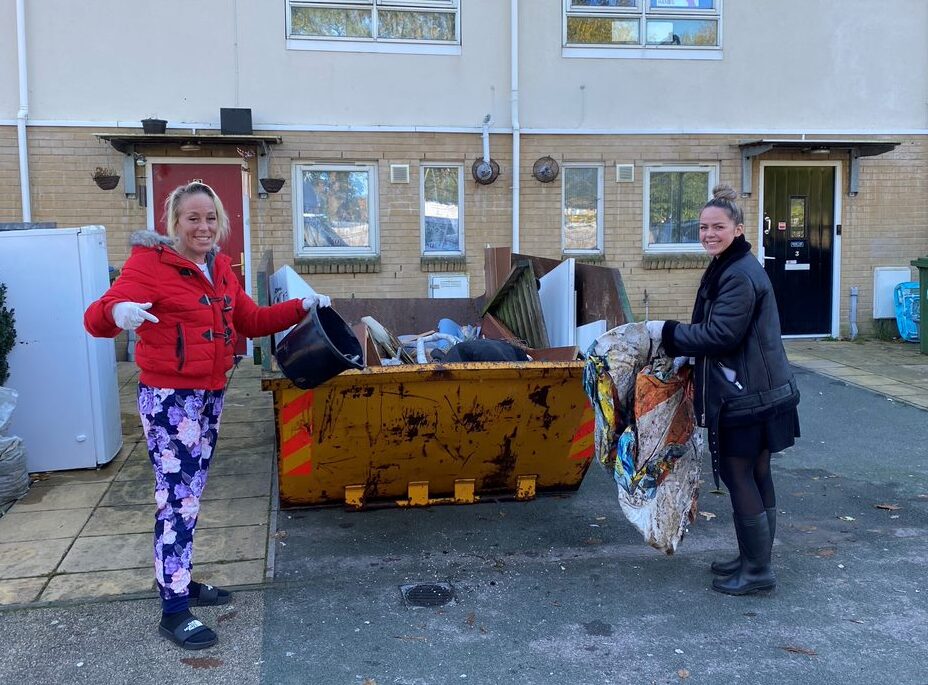Finding decent temporary accommodation for homeless households has become one of the biggest challenges facing councils and housing associations. In an exclusive for HQM, Keith Cooper explores how social landlords are responding to what’s become a national problem.
The official figures are all headed in the wrong direction. The number of households in temporary accommodation are now at record levels: 104,510 at the last count following an upward journey that began in 2010. This figure includes 131,370 children, thousands of whom were in the worst kind – bed and breakfast-style accommodation – which can see them crammed into a single room with their parents, siblings, and all their belongings.
And as demand spirals, councils must also now contend with a relatively new challenging trend. Private landlords have begun demanding back the properties on which councils previously relied for this supposed stopgap supply. The number of ‘notice to quits’ issued by such landlords to London local authorities jumped 120% last year, from 1,601 in 2022 to 3,531 in 2023 according to figures from London Councils, the umbrella body for the capital’s councils.
Notting Hill Genesis, a London-based housing association that manages 3,000 units of temporary accommodation, has had 450 landlords ask for their properties back. “They have realised that they can earn more in the private sector,” the association’s director of supported and temporary accommodation director, Robert East, told a Westminster conference in September. “As mortgage rates have risen, many are saying that we’re not paying enough to cover their costs. If we don’t get an increase in the rents we pay landlords [those properties] are going to be lost and people are going to be stuck in bed and breakfasts.”
Such an increase looks unlikely any time soon. After being frozen for years, local housing allowance no longer covers market rents in many areas, leaving increasing numbers of authorities with little choice but to re-house homeless households outside their areas, cutting them off from their families, friends and support networks.
With such worrying trends, it’s no surprise that the topic of temporary accommodation has attracted the attention of researchers and the media, an interest that’s casting new light on this ballooning crisis and its real-life impact on the individuals and families caught up in it.
Spiralling demand
So, what do we know about the state of temporary accommodation and its harmful effects on those living in it? And against this backdrop of spiralling demand and decreasing supply, is there anything more that social landlords can do to help those who get stuck in it?
For this article we have accessed exclusive and published research and commentary from councils, researchers and the frontline charities which support individuals and families in temporary accommodation.
“Local authorities have been more focused on rough sleeping than on family homelessness. But in Manchester we are saying it’s an absolute priority to do better for families”
Rob McCartney, assistant director of homelessness services, Manchester City Council
Evidence points to the fact that the practice of moving households out of area has spread beyond London and that many households are now stuck in the ‘limbo’ of OOA (out-of-area) temporary accommodation for years. And analysis shows households with Black African or Caribbean heritage are disproportionately moved out of area and so are subject to all the risks such displacement involves.
In a move to mitigate the problems, councils are collaborating with charities and landlords in so-called TAAGs (temporary accommodation action groups) to make meaningful improvements for homeless households, and how one council is piloting a more family-friendly approach which has so far seen a dramatic reduction in the number of families housed in bed and breakfast accommodation.
London councils have long relied on neighbouring boroughs to augment their own supply of temporary accommodation for homeless households. But our analysis of more than 32,000 placements in the three years between 2018/19 and 2021/22 shows this practice has spread across the country.
Shunted miles away

During that period, more than 2,500 households were shunted more than 20 miles from their local neighbourhood by councils outside the capital. Just over 200 households were moved more than 50 miles away. Birmingham rehoused households in Ipswich more than 150 miles away and Canterbury sent one household 130 miles away to accommodation in Hampshire. In total, across the country, including London, councils rehoused 137 households more than 100 miles away from their local areas.
And while these larger distances might seem the most alarming, homelessness charities say that even small distances can be disruptive, especially for low-income families dependent on public transport. A 10-mile trip between Redbridge and Islington, for instance, takes 46 minutes by car but over an hour by public transport. This would be an obviously onerous two-hour return trip for a parent keeping a child in school in their home borough.
Freedom of Information figures show that many households are spending prolonged periods in temporary accommodation, as long as nine years in one case. Our analysis looked at data supplied by 56 authorities which used OOA placements. It found that 9,400 households in 40 authorities had lived outside their areas for more than two years. Barking and Dagenham Council has placed hundreds of households outside of its borough boundaries for more than a year, with five still there nine years after their original placement. More than 80% of households rehoused by Brent outside its boundaries were still there one year later, the analysis indicates. In Lambeth, that proportion is 76%.
Barking and Dagenham says most of its OOA households are in “directly neighbouring boroughs”, with most of the rest in neighbouring Essex. It keeps contact with its homeless households and offers them support, advice and assistance, a spokesperson added. Like many London boroughs which send households out of area, it’s also home to homeless families sent by other boroughs. In Barking and Dagenham’s case, it has 232 of its own homeless households in other local authorities while hosting 473 from other boroughs.
Brent Council says it kept regular contact with households in temporary accommodation for prolonged periods. “Any support issues that are identified are tailored to meet the individual needs of the families,” a spokesperson added.
Disproportionate impact
Further analysis of the FoI data raises questions about the disproportionate impact of OOA placements on households with Black or Asian heritage. This analysis, first published in Inside Housing, examined the ethnicities of households placed out of area in 15 authorities between 2018-19 and 2020-21. It also examined data from four councils that found people temporary accommodation outside of their areas.
It found that between 2018-19 and 2020-21, Black and Asian-led households were placed out of area to a disproportionate degree in most authorities. Councils that rehouse many Black-led households also do so in predominantly white areas.
During this three-year period, 12 of the 15 authorities studied housed a greater proportion of Black or Asian households out of area. These disparities were identified by comparing the ethnicities of homeless households helped by the councils with the ethnicities of households housed out of area.
Figures for Havering, in east London, show that in 2020-21, of the 62 households at that time housed out of area, 31% were Black households. To put this in context, 15% of the households it helped with homelessness were Black, and Black people made up 8% of Havering’s total population in 2021, according to that year’s census. The pattern is similar elsewhere. Almost half (49%) of the households Greenwich Council sent out of area were Black-led in 2019-20, compared with 38% of the households it helped that year. In some areas, this disparity has grown. In Birmingham, it increased from 1% in 2018-19 to 7% in 2020-21.
The analysis also found that some authorities frequently put Black-led households in accommodation in predominantly white neighbourhoods. Birmingham places 204 Black households outside the city on average each year, but frequently sends homeless households to B79 in Tamworth, Staffordshire. This postcode splits into nine sub-areas, only five of which have a Black population of more than 1%, according to the 2021 Census. Redbridge sends households 65 miles away to an area of Tendring, Essex, which includes Jaywick Sands, a predominantly white area and one of the most deprived in England.
“Research by the National Child Mortality Database linked 34 child deaths from recent years with temporary accommodation”
Heriot-Watt University professor of urban studies Glen Bramley says some of the apparent disparities identified by the analysis looked significant. “Regrettably, harassment of ethnic minority households in ‘white working class’ areas, particularly council estates in more peripheral locations, is a long standing problem, and clearly it continues,” he added. “Being placed a long way from your borough of origin, into an area which combines poverty/deprivation with a lack of population from your ethnic group, as in the Tendring /Jaywick case, seems clearly wrong and risky.”
Birmingham Council recognised it had increasingly moved Black African and Caribbean households outside the city, as their families were often larger. It’s spent £60m on bigger homes in the city and did its “utmost to ensure that all families outside the city are appropriately supported,” a spokesperson said. Havering Council pledged to review all its OOA placements “to eliminate all forms of discrimination”. Greenwich Council says its placement policy follows statutory provisions, government guidelines and case law and “doesn’t discriminate”.
The impact on children
Other councils are responding to the growing temporary accommodation challenge in other ways. Manchester City Council has, for instance, recently adopted a more family-friendly policy geared toward reducing the number of households with children in bed and breakfast accommodation.
This move comes amid growing concern about the impact of temporary accommodation on babies and young children.
Research last year by the National Child Mortality Database linked 34 child deaths from recent years with temporary accommodation. And continuing studies examining the impact on child health, begun during the pandemic, found children in temporary accommodation suffering from malnutrition and breathing problems from living in damp and mouldy, poorly ventilated rooms.
The Champions Project research group, led by Monica Lakhanpaul, professor of integrated community child health and honorary consultant paediatrician at the UCL Great Ormond Street Institute of Child Health, found that the conditions in temporary accommodation were even stunting child development. “Children were often stuck in housing with not much space to play,” says Professor Lakhanpaul. “They can’t walk in such tiny rooms. Parents are frightened to send their children to playgrounds, for fear of where some are located.”
Under Manchester Council’s new approach, senior managers carry out case checks and oversee move on panels to help clear caseloads. This had helped reduce the number of families in bed and breakfasts this year from 227 to zero and cut a projected budget shortfall from £25m to £2.5m. “Local authorities have been more focused on rough sleeping than on family homelessness,” the council’s assistant director of homelessness services Rob McCartney told a Westminster conference organised by the charity Justlife in September. “But in Manchester we are saying it’s an absolute priority to do better for families.”
TAAG teams

Councils are also helping families and individuals in temporary accommodation by joining TAAGs. These are a network of regular meetings between support charities, councils, and landlords. TAAGs are already up and running in Brighton and Hove, Manchester, East Sussex, Hackney, Westminster, Newham, Waltham Forest, and Bristol. They’re co-ordinated by Justlife, which says other areas are wanting to set them up.
“TAAG meetings aren’t somewhere for people to sound off about their frustrations. They are a no-blame environment,” says Signe Gosmann, network development and researcher at Justlife. “Everyone at these meetings holds a piece of the puzzle and they are better together than when they operate alone.”
Brighton and Hove TAAG meets every three months, is attended by council officials, landlords, adult social care, councillors, and people with lived experience of homelessness, and is chaired by Martin Coll, Justlife’s head of service in the city. “We try to be as solution-focused as possible while realising our limits in terms of primary legislation and our own experience,” he says.
As a result of the TAAG’s work, the council now has an agreed set of minimum standards for basic facilities such as linen, cooking facilities and heating, known as the emergency accommodation charter. The council has also introduced “dynamic purchasing” which allows it to stop using poor quality providers more easily.
“Freedom of Information figures show that many households are spending prolonged periods in temporary accommodation, as long as nine years in one case”
The TAAG is also a forum for information sharing, Mr Coll says. “A lot of the time providers have very little information about their clients. By sharing information, providers are informed and so can act accordingly. Sometimes, it’s just about ensuring they’ve got useful phone numbers so if someone has a mental health worker, and they are in crisis, they can contact them.”
Ms Gosmann admits TAAGs are not perfect; they depend on people turning up and the worst landlords don’t. “Some landlords worry that they are going to get shouted at and there are many out there who are really rogue who we aren’t reaching. It’s not model that’s going to work for them.”
One landlord who has thrown himself into the TAAG in East Sussex is Michael Groves. Mr Groves owns 30 properties, mainly in Hastings, including a block of one-bedroom flats, a six-room women’s refuge, and a house in multiple occupation. For him, the main benefit is in networking. “There’s a lot of support out there for homeless people who have drug, alcohol or mental health problems, but as providers we don’t necessarily know who those people are.”
The East Sussex group has also led work to drive up standards, ensuring that basic facilities are provided in rooms even when they’re available in shared spaces. “A lot of people are anxious about shared kitchens,” adds Mr Groves.
Frustrations
Like other members of his TAAG, Mr Groves admits to “frustrations” in the temporary accommodation sector. “None of us have the power to make big changes.” It’s a feeling with which many working in this challenging area will sympathise. But as Mr McCartney told the Westminster conference in September, councils don’t need to accept the “air of defeatism” which a sole focus on the depressing bare facts of temporary accommodation creates. Not when there’s still so much more they can do to improve the lives of the individuals, families and children who are stuck there.





















